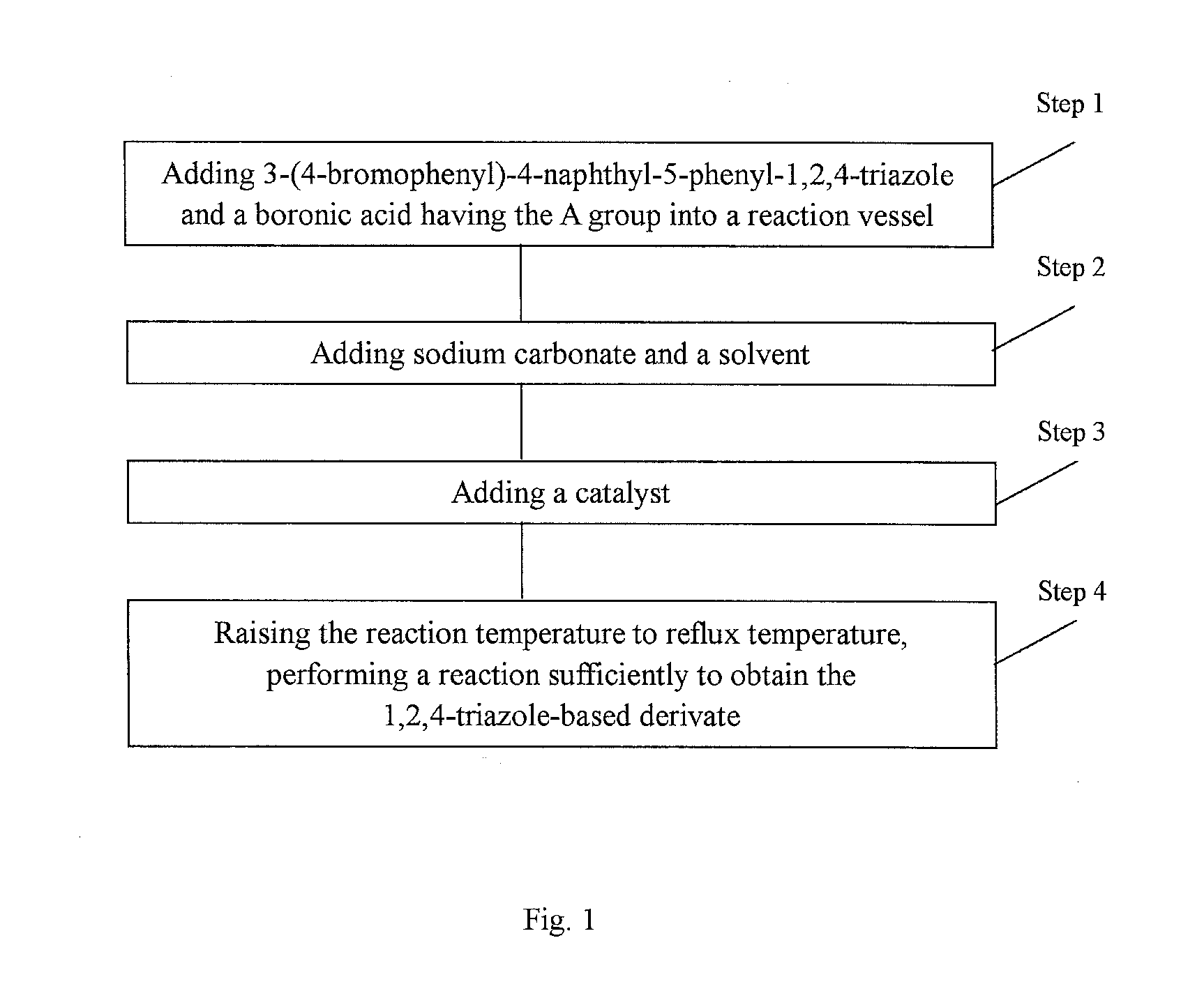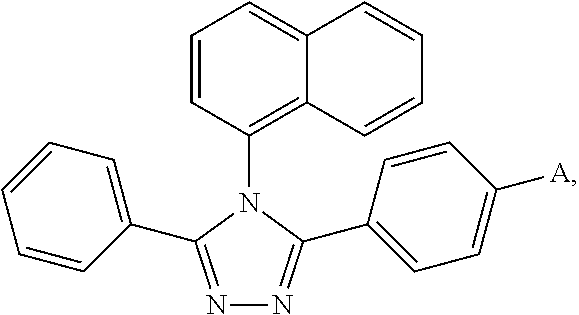1, 2, 4-triazole-based derivative, production process and use thereof, and organic electroluminescent device
- Summary
- Abstract
- Description
- Claims
- Application Information
AI Technical Summary
Benefits of technology
Problems solved by technology
Method used
Image
Examples
example 1
Synthesis of Compound 001
[0065]Under a nitrogen environment, 3-(4-bromophenyl)-4-naphthyl-5-phenyl-1,2,4-triazole (21.32 g, 50 mmol) and N-phenyl-3-carbazyl boronic acid (21.53 g, 75 mmol) were added into a three-necked flask equipped with a heating means, a refluxing means and a stirring means. Then sodium carbonate (15.90 g, 150 mmol), toluene (250 ml) and water (125 ml) were added. Finally, tetrakis(triphenylphosphine)palladium (0.57 g, 0.5 mmol) was added. The temperature was raised to 70° C., and the mixture was reacted for 24 hours while refluxing. After the mixture was cooled to the room temperature and a solid was precipitated, vacuum filtration was carried out. After the resultant filter cake was washed with water, ethanol and diethyl ether in this order, it was purified by column chromatography (petroleum ether:ethyl acetate=1:8). The mixed solvent was recovered. After drying, an off-white Compound 001 (27.37 g) was obtained, and the yield thereof was 93% or more.
[0066]The...
example 2
Synthesis of Compound 002
[0069]Under a nitrogen environment, 3-(4-bromophenyl)-4-naphthyl-5-phenyl-1,2,4-triazole (21.32 g, 50 mmol) and 4-(4-triphenylamine)naphthyl boronic acid (31.52 g, 90 mmol) were added into a three-necked flask equipped with a heating means, a refluxing means and a stirring means. Then sodium carbonate (16.56 g, 160 mmol), toluene (250 ml) and water (125 ml) were added. Finally, tetrakis(triphenylphosphine)palladium (0.69 g, 0.6 mmol) was added. The temperature was raised to 75° C., and the mixture was reacted for 25 hours while refluxing. After the mixture was cooled to the room temperature and a solid was precipitated, vacuum filtration was carried out. After the resultant filter cake was washed with water, ethanol and diethyl ether in this order, it was purified by column chromatography (petroleum ether:ethyl acetate=1:8). The mixed solvent was recovered. After drying, an off-white Compound 002 (27.47 g) was obtained, and the yield thereof was 93% or more....
example 3
Synthesis of Compound 003
[0073]Under a nitrogen environment, 3-(4-bromophenyl)-4-naphthyl-5-phenyl-1,2,4-triazole (21.32 g, 50 mmol) and 10-(2-naphthyl)anthracyl boronic acid (40.40 g, 115 mmol) were added into a three-necked flask equipped with a heating means, a refluxing means and a stirring means. Then sodium carbonate (25.4 g, 190 mmol), toluene (250 ml) and water (125 ml) were added. Finally, tetrakis(triphenylphosphine)palladium (0.45 g, 0.9 mmol) was added. The temperature was raised to 80° C., and the mixture was reacted for 28 hours while refluxing. After the mixture was cooled to the room temperature and a solid was precipitated, vacuum filtration was carried out. After the resultant filter cake was washed with water, ethanol and diethyl ether in this order, it was purified by column chromatography (petroleum ether:ethyl acetate 1:8). The mixed solvent was recovered. After drying, an off-white Compound 003 (22.26 g) was obtained, and the yield thereof was 94% or more.
[00...
PUM
 Login to View More
Login to View More Abstract
Description
Claims
Application Information
 Login to View More
Login to View More - R&D
- Intellectual Property
- Life Sciences
- Materials
- Tech Scout
- Unparalleled Data Quality
- Higher Quality Content
- 60% Fewer Hallucinations
Browse by: Latest US Patents, China's latest patents, Technical Efficacy Thesaurus, Application Domain, Technology Topic, Popular Technical Reports.
© 2025 PatSnap. All rights reserved.Legal|Privacy policy|Modern Slavery Act Transparency Statement|Sitemap|About US| Contact US: help@patsnap.com



